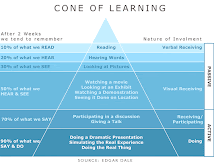
A (Very) Brief History of Learning Theory
Matthew D. Laliberte
Worcester Polytechnic Institute
NERCOMP SIG 01.19.05
Learning as a Black Box
So what’s happening inside the box?
A Superficial Review
- Behaviorism
- Cognitivism
- Social Learning Theory
- Social Constructivism
- Multiple Intelligences
- Brain-Based Learning
Behaviorism
- Learning is defined by the outward expression of new behaviors
- Focuses solely on observable behaviors
- A biological basis for learning
- Learning is context-independent
- Classical & Operant Conditioning
- Reflexes (Pavlov’s Dogs)
- Feedback/Reinforcement (Skinner’s Pigeon Box)
Behaviorism in the Classroom
- Rewards and punishments
- Responsibility for student learning rests squarely with the teacher
- Lecture-based, highly structured
Critiques of Behaviorism
- Does not account for processes taking place in the mind that cannot be observed
- Advocates for passive student learning in a teacher-centric environment
- One size fits all
- Knowledge itself is given and absolute
- Programmed instruction & teacher-proofing
Cognitivism
- Grew in response to Behaviorism
- Knowledge is stored cognitively as symbols
- Learning is the process of connecting symbols in a meaningful & memorable way
- Studies focused on the mental processes that facilitate symbol connection
Cognitivism cont.
- Jean Piaget
- Genetic Epistemology
- Assimilation and Accommodation
- Jerome Bruner
- Discovery Learning
- Learner as independent problem-solver
Cognitivism in the Classroom
- Inquiry-oriented projects
- Opportunities for the testing of hypotheses
- Curiosity encouraged
- Staged scaffolding
Critiques of Cognitivism
- Like Behaviorism, knowledge itself is given and absolute
- Input – Process – Output model is mechanistic and deterministic
- Does not account enough for individuality
- Little emphasis on affective characteristics
Social Learning Theory (SLT)
- Grew out of Cognitivism
- A. Bandura (1973)
- Learning takes place through observation and sensorial experiences
- Imitation is the sincerest form of flattery
- SLT is the basis of the movement against violence in media & video games
- Bobo Doll Experiment
SLT in the Classroom
- Collaborative learning and group work
- Modeling responses and expectations
- Opportunities to observe experts in action
Critiques of Social Learning Theory
- Does not take into account individuality, context, and experience as mediating factors
- Suggests students learn best as passive receivers of sensory stimuli, as opposed to being active learners
- Emotions and motivation not considered important or connected to learning
Social Constructivism
- Grew out of and in response to Cognitivism, framed around metacognition
- Knowledge is actively constructed
- Learning is…
- A search for meaning by the learner
- Contextualized
- An inherently social activity
- Dialogic and recursive
- The responsibility of the learner
- Lev Vygotsky
- Social Learning
- Zone of Proximal Development
Social Constructivism in the Classroom
- Journaling
- Experiential activities
- Personal focus
- Collaborative & cooperative learning
Critiques of Social Constructivism
- Suggests that knowledge is neither given nor absolute
- Often seen as less rigorous than traditional approaches to instruction
- Does not fit well with traditional age grouping and rigid terms/semesters
Multiple Intelligences (MI)
- Grew out of Constructivism, framed around metacognition
- H. Gardner (1983 to present)
- All people are born with eight intelligences:
- Enables students to leverage their strengths and purposefully target and develop their weaknesses
8. Intrapersonal
4. Kinesthetic
7. Interpersonal
3. Logical-Mathematical
6. Naturalist
2. Visual-Spatial
5. Musical
1. Verbal-Linguistic
MI in the Classroom
- Delivery of instruction via multiple mediums
- Student-centered classroom
- Authentic Assessment
- Self-directed learning
Critiques of MI
- Lack of quantifiable evidence that MI exist
- Lack of evidence that use of MI as a curricular and methodological approach has any discernable impact on learning
- Development process is a time-sink
- Suggestive of a departure from core curricula and standards
Brain-Based Learning (BBL)
- Grew out of Neuroscience & Constructivism
- D. Souza, N. Caine & G. Caine, E. Jensen (1980’s to present)
- 12 governing principles
12. Every brain is unique
6. Processing of parts and wholes
11. Challenge & threat
5. Emotions are critical
10. Embedded learning sticks
4. Patterning
9. Several types of memory
3. A search for meaning
8. Conscious & unconscious processes
2. Whole body learning
7. Focused attention & peripheral perception
1. Brain is a parallel processor
BBL in the Classroom
- Opportunities for group learning
- Regular environmental changes
- A multi-sensory environment
- Opportunities for self-expression and making personal connections to content
- Community-based learning
Critiques of BBL
- Research conducted by neuroscientists, not teachers & educational researchers
- Lack of understanding of the brain itself makes “brain-based” learning questionable
- Individual principles have been scientifically questioned
Other Learning Theories of Note
- Andragogy (M. Knowles)
- Flow (M. Czikszentmihalyi)
- Situated Learning (J. Lave)
- Subsumption Theory (D. Ausubel)
- Conditions of Learning (R. Gagne)
Learning as a Not-So-Black Box
Biological basis for learning – you have it or you don’t…it’s a thing you inherit
Grew in response to Behaviorism in an effort to better understand the mental processes behind learning
Assimilation: The integration of new information into an existing symbol system
Accommodation: The adjustment of internal symbol systems to make space for new information that challenges the structure
Staged scaffolding: not based on ability or experience…based on developmental stage (age most predominantly)
Does not account enough for individuality and differences in staged development
Little emphasis on affective characteristics, especially motivation
Imitation: Individuals adopt the modeled behavior more readily and completely if the person they are observing is admired by the observer
We more readily model behavior if it results in outcomes we value or approve of
Think of a laboratory environment, for instance. What’s more effective in your estimation…watching the faculty member conduct the lab, or you doing it yourself?
Knowledge is actively constructed by individuals in light of and in relation to our past experiences, the context of learning, personal motivation, and our beliefs/attitudes/prior knowledge
Think of the lab…instead of just watching it being done, the student acts as the active agent conducting the lab, with expert support leading them to the edge of their knowledge and beyond.
Dialogic: central focus is on written & spoken dialogue
Recursive: new learning is built upon prior learning…scaffolding
Suggests that knowledge is neither given nor absolute, but is rather an individual construct
Does not fit well with traditional age grouping and rigid terms/semesters that do not provide a flexible timeframe for learning
Metacognition – simply put is learning about learning, but more realistically, it’s about kn owing who you are as a learner, and developing the capacity to leverage your strengths to your advantage while purposefully addressing your weaknesses
Individual principles have been scientifically questioned (left/right brain laterality)
On-The-Job Training (OJT)
Chinese Philosophy - 5th-century BC
Greek Philosophy - 300 BC
Apprenticeship - Middle Ages
Early Schools and Pedagogy - 10th Century
John Comenius - (Jan Komensky) (1592-1670)
John Locke (1632-1704)
Jean Jacques Rousseau - 1762
Johann Heinrich Pestalozzi - late 1700s
Gaming - 1800s
Johann Friedrich Herbart (1776-1841)
The Lyceum - 1826
Vestibule Training - late 1800s
Case Method (Case Study) - 1880s
Correspondence Schools - 1883
Word War I - Show, Tell, Do, and Check - 1917
John Dewey - (1867-1949)
Yerkes-Dodson law - Arousal - 1908
Role-playing - 1910
Frederick Winslow Taylor (1856-1950)
Ivan Pavlov - Stimulus-Response - 1927
J. B. Watson and Behaviorism - 1900s
Gestalt - 1912
The Teaching Machine - 1924
Eduard C. Lindeman - 1926
Edward L. Thorndike (1874-1949)
Andragogy - 1920s
Hawthorne Effect - 1932
Jean Piaget (1896-1980)
Likert Scales - 1932
Constructivism - 1930s
Discovery Learning - 1940s
Job Instruction Training (JIT) - 1940s
Job-Performance-Aid (or Job Aid) - 1940s
The American Society for Training and Development
Abraham Maslow (1908-1970)
Practice - 1946
Kurt Lewin (1890-1947)
T-Groups - 1947
Organizational Development - 1949
Cognitive Science - 1950s
Instructional Systems Design (ISD) - 1950s
Benjamin Bloom - 1956
Don Kirkpatrick and Evaluating Training - 1959
Herzberg's Motivational Factors - 1959
B. F. Skinner (1904 -1990)
Theory X and Theory Y - 1960
Carl Rogers (1902-1987)
Albert Bandura - 1960s
Instructional Design - 1962
Performance Objectives - 1962
Robert Gagne - 1962
The Blake and Mouton Managerial Grid - 1964
Training Magazine - (1964)
Alan Tough - 1968
Fred Keller (PSI) - 1968
Malcom Knowles - 1970
Performance Improvement - 1978
Lifelong Learning - 1981
The Grandfather of Business Books - 1982
Howard Gardner and Multiple Intelligences - 1983 Kolb's
Learning Styles - 1984
Adult Education - 1986
Computer Based Training (CBT) - 1980s
Dilbert - 1989
Electronic Performance Support System - 1989
The Learning Organization - 1990
Knowledge Management - 1997
The Future - 2000 and beyond
Reference
Artwork Credits


Tidak ada komentar:
Posting Komentar